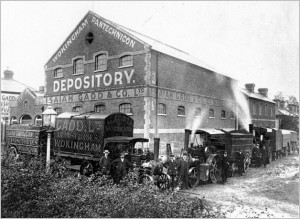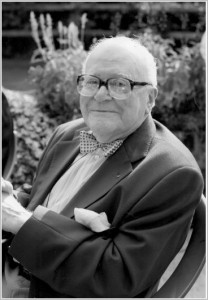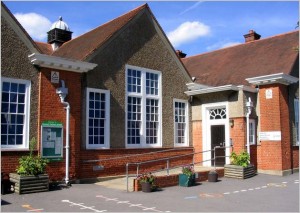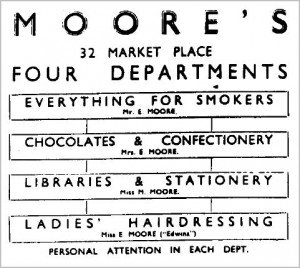Jim Bell continues with the magnificent series of recollections by Cecil Culver, one of the great cornerstones of Wokingham’s 20th century community. Cecil died in 2009 aged 99, but we are fortunate in being able to receive his memories of Wokingham during and after the Great War.
Cecil William Lewis Culver was born at home, 185 Broomwood Road, Battersea, on the 7th of June 1910. He always remembered this address because, as soon as he was able to speak, his father taught him to say his name and address in case he was lost. Cecil’s parents, William Culver (1869-1934) and Florence Amée Culver (1879-1965) had married in 1909.
Cecil and Florrie left Clapham just after William, who was serving as an officer in the army and who was rarely at home, was called back to his regiment in June 1914. Florrie realised that the First World War was going to last for some time and didn’t relish the prospect of living in London on her own with a small boy when her parents had a big house in Wokingham. She therefore made arrangements to move the family possessions to her father’s home at 22 Sturges Road, Wokingham.
The first time Cecil saw Ernie Reeves was when he and Florrie went to Gadd’s removal company office, in Broad street, to make arrangements for the transportation of their furniture. Little did the four-year old Cecil realise that the youth he saw in the shop, with his hair parted in the middle, would be his manager for many years.
Said Cecil—
“In those days removals were either carried out by rail or by horse and cart, so Ernie sent one of those standard pantechnicons up to London to pick up the furniture and bring it to Wokingham. All these furniture vans were built on the same lines. All the removers had the same. They were tunnel vans with two big wheels in the back, and small ones in the front, and a seat on the top for the driver. Ernie’s team left Wokingham and travelled as far as Hounslow, where they stayed with the horses, and the men got a bed for the night. On the second day they went into London, loaded up, came back to Hounslow for the night again. Third day it was from Hounslow to Wokingham, and on the morning of the fourth day, they unloaded. It took three and a half days. Steam-drawn wagons were never very satisfactory because first of all you had to carry coal with you. It was usually carried in sacks on the back of the van that was being drawn. It was mucky of course. You had to make sure you didn’t get it mixed in with the furniture. Then of course you had to pick up water on the way. And unless you knew the geography of the place to which you were going you could land up with a dry engine. Eversley Cross was where they’d pick up water at the bridge. Then they’d probably go on to Sherfield-on-Loddon and pick up more water that would take them into Basingstoke.
But that’s the way they did it. It didn’t last very long. Bishop’s had one. I saw the actual thing that had been rubbed up as a showpiece and Roger Bishop was driving it. You had to go in the direction of the water so you had no advantage really. They could employ them only on short hauls where they may pick up a bit of time otherwise it was horse-drawn.
There were no internal combustion engines fitted to lorries or anything like that during the First World War and whenever you have war there are always many things that are pushed forward and the internal combustion engine was one. Because Churchill, who was the warlord at the time, was much the same as he was in the Second World War—pushing—and he got engines developed that would power a lorry. They weren’t as big as the ones we have now but they were big enough to carry troops and ammunition to and from the front. Of course with further development he was able to use a tank.
The internal combustion engine came into its own during wartime and it was only after the war that a lot of these lorries were sold off cheaply by the government and that’s when you started to get vehicles on the road. But here in Wokingham you could count the cars that were owned on the fingers of one hand. There were no buses or anything like that—nothing in the way of lorries. London had buses but they were very small things. They had rubber tyres—nothing like buses you have now. They were much the same. Their tyres were more like bicycle tyres.”
William Culver (1847-1924), Cecil’s grandfather, was a master carpenter. Born in Merrow, near Guildford, his previous employers included Wixenford School (Ludgrove School area), where he was a cabinet-making instructor; John Walter III of Bearwood and the Rev. Joseph Stratton, master and chaplain, of the Lucas Hospital.
Soon after he came to Wokingham William married Jane (1847-1917), a daughter of the Lewis family, who were long-established Wokingham builders. William and Jane first moved into No. 22 Carey Road. They had three children: Horace (b. 1875); Lilian Emily (1877-1937) and Florence Amée (1879-1965).
A public-spirited man William put himself up for election as town councillor in November 1897 but was unsuccessful. He succeeded in the following year serving in the council until 1904. During this period he served on a number of committees including Bye Laws, School Attendance, Pleasure Grounds and Lighting.
William a carpenter, and Horace an architect, began to construct houses in the town. They built the next family residence, No. 22 Langborough Road, and seven others in Sturges Road, including No. 22, Corra Lorne and No. 24, Southwell. According to Roger Hoskings, who resides in a Culver house in Sturges Road, “The woodwork in the houses he built reflect William’s mastery of his woodworking.” William was closing down his business when Cecil and Florrie came to live with them. 41 Corra Lorne was to be the last address of Cecil and his brother Derek John Lewis (1917-2003) who eventually became the longest established residents in Sturges Road.
Cecil started his education at Wescott Road Primary School at the age of five. He was sent to Wescott because a grand aunt, a Miss Lewis, was teaching there. It became apparent that Cecil was very intelligent for he won a scholarship to continue his education at Ranelagh School in Bracknell. He studied at Ranelagh from 1921 to 1927 passing his examinations with excellent marks. He also developed a lifelong affection for his school and left with many happy memories.
Said Cecil—
“There were only just over a hundred of us at Ranelagh in those days. We were put through the hoop pretty well. The headmaster was a very keen character and the staff was good. I called on one of the staff in 1982. I was doing duty for Bishop’s in Liverpool and I found she was in an old persons’ home, only a stone’s throw from the office in Birkenhead, so I thought I’ll go round and see her.
When somebody said, “Will you see Mr Culver?” I heard her voice saying, ”Yes of course I will. Show him in. He’s one of my old boys!” She was 87, as bright as a cricket. The only problem was that she was a bit dodgy in getting around. She had a bit of rheumatism I think. She asked about everybody and didn’t forget the names of anyone. She wanted to know about everybody”.
Soon after leaving school, Cecil joined Ranelagh Old Boys’ Society as an active member, and approximately two years after the end of the Second World War, he and a group of fellow supporters formed the Friends of Ranelagh. Cecil was elected Chairman, a position he occupied for well over forty years. During the fifties, he and his Committee were instrumental in compiling and putting into operation a programme of building and modernisation. Later, in the mid seventies, they supported the then Headmaster, Mr Richard Allen, when the future of the School was in very considerable doubt because of the introduction of the comprehensive system. There is little doubt that the Friends contributed very considerably towards the successful school it is to this day. When Mr Allen wrote History of Ranelagh, published in the millennium year, he drew upon the phenomenal memory which Cecil had for names, places and dates for the compilation of his work.
Cecil’s first job upon leaving school was as a clerk in a bank in Whitehall travelling there daily from Wokingham to Waterloo by steam train. Although the train stopped at almost every station, the journey took only five minutes longer than it does now by electric train. He didn’t care for the job, and after working there for six years, the depression came and staff were made redundant. Cecil left the company and found employment with an insurance firm in Reading.
In the mid-thirties Cecil met, and fell in love with, Edwina Marie Teresa (1913-1965), daughter of Edwin Moore, the owner of a four departmental shop in the Market Place, and who lived around the corner in Denton Road. One of the departments was a hairdressing salon run by Edwina, the centre of Cecil’s attractions.
Edwina later went into business for herself eventually opening two salons at Nos. 13 and 23 the Market Place and one in Church Street, Crowthorne. The happy couple were married at All Saints Church on the 9th of June 1937 after which they moved into the flat above the salon at No. 13 Market Place where they resided for the next sixteen years.
Edwina sold the business in 1953 and she and Cecil moved to Corra Lorne that was still occupied by Cecil’s mother and Horace. Jane was severely arthritic and had difficulty climbing the stairs only coming down in the morning and going up to her bedroom in the evening. As her condition was worsening Cecil advised her and Horace to move downstairs. Using some money that had been left to him by an old friend Cecil turned the house into two separate apartments and he and Edwina moved into the upper one. This was very convenient for them being only a few yards from the centre of the town.





Outstanding,
Would it be possible to display the photo on my site, with credit to yourself,
Thanking you in anticipation,
James Sharp.
Hi Jim, yes of course. Although it’s a mouthful, could you credit ‘Jim Bell at Wokingham Remembers’. It would be good to see the website page. Regards, Mike
Thanks Mike,
Photo now on display.
Google – James Sharp Furnitue Van Photos.
Mike – If you have any more photos relating to my site and woud like displayed, then please e-mail.
Thanks again,
James Sharp.
Hi James, It looks great and what a project you have on your hands. I set up a wokingham remembers Facebook account and now use their timeline. I started the clock from 1870 and am in the process of adding all the people, events and inventions, which led to both world wars. I’ve also dropped in local Wokingham news where I can. The timeline is starting to show how other things came about. For instance, HG Wells was fascinated by inventions and this culminated in him writing War of the Worlds, which in turn is an icon of our own childhoods. There are other pieces I will add to the timeline, including Rudyard Kipling and Conan Doyle etc. It occurred to me (but don’t want to tell you how to suck eggs) that if you placed your vehicles in a timeline, it would show the development of transport and industry; other facts could also be added to illustrate how these businesses became popular or bankrupt. Just an idea.
Cheers and thanks for the contact.
Mike
Hi Mike, Yeh I wish it was that easy, thought of all those ideas. You will find out that Facebook without any notice start to remove photos from the time line to free up space and it’s not until you are looking through and saying to yourself where’s this photo and where’s that photo gone, oh yes the photo is still in the albums but the time line idea does not work. I left virgin in 2010 to join Facebook because virgin was a nightmare, photos would not upload etc etc. Facebook has changed their layout and page set up three times since I joined, I used to have the albums in alphabetical order and every time the layout was changed the albums were all over the place, I sat for hours, days even dragging them back into order – a total waste of time, the next time they changed the same thing happened – hence they are all over the place to this day, if you want to find something you have just got to search through.
All this you will find out in time, because it’s free they can do what they want.
Anyway, Good luck with the site and I wish you all the best,
Cheers for now,
James.
Oops sorry Jim, you sound really cheesed off and I can understand why! I’m 57 and have messed around with tec stuff since the early eighties. I can’t tell you the number of times i have wanted to stamp on whatever piece of rubbish I bought which promised a solution to all my woes. I can see you’re in that mode and I really am sorry to have stirred all that up. I’ve been using Facebook a lot to help me tie up a lot of dates and incidents, but I’m not sure what to do now you’ve warned me with your experience. I think I’ll load it onto my website and just keep it simple.
Cheers, Mike
Hi Mike,
Here’s wishing you and yours a very happy christmas and a contented 2014.
Cheers for now,
James.